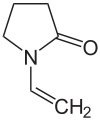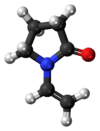N-Vinylpyrrolidone
| |||
| Names | |||
|---|---|---|---|
| IUPAC name
1-Ethenyl-2-pyrrolidone | |||
| Other names
N-Ethenyl-2-pyrrolidone N-Vinyl-2-pyrrolidone 1-Vinyl-2-pyrrolidone N-Vinylbutyrolactam | |||
| Identifiers | |||
| 88-12-0 | |||
| 3D model (Jmol) | Interactive image | ||
| ChemSpider | 6651 | ||
| ECHA InfoCard | 100.001.637 | ||
| PubChem | 6917 | ||
| UNII | 76H9G81541 | ||
| |||
| |||
| Properties | |||
| C6H9NO | |||
| Molar mass | 111.14 g·mol−1 | ||
| Density | 1.04 g/cm3[1] | ||
| Melting point | 13–14 °C (55–57 °F; 286–287 K) | ||
| Boiling point | 92–95 °C (198–203 °F; 365–368 K)[1] 11 mmHg | ||
| Vapor pressure | 0.1 mmHg (24 °C)[1] | ||
| Refractive index (nD) |
1.512[1] | ||
| Hazards | |||
| Flash point | 95 °C (203 °F; 368 K) | ||
| 685 °C (1,265 °F; 958 K) | |||
| Except where otherwise noted, data are given for materials in their standard state (at 25 °C [77 °F], 100 kPa). | |||
| | |||
| Infobox references | |||
N-Vinylpyrrolidone ("NVP") is an organic compound consisting of a 5-membered lactam linked to a vinyl group. It is a colorless liquid although commercial samples can appear yellowish.
It is produced industrially by reacting 2-pyrrolidone with acetylene.[2] It is the precursor to polyvinylpyrrolidone (PVP), an important synthetic material. The NVP monomer is commonly used as a reactive diluent in ultraviolet and electron-beam curable polymers applied as inks, coatings or adhesives.[2]
See also
- Methylpyrrolidone (NMP)
- 2-Pyrrolidone (2-Py)
References
- 1 2 3 4 "1-Vinyl-2-pyrrolidinone". Sigma-Aldrich.
- 1 2 Albrecht Ludwig Harreus, R. Backes, J.-O. Eichler, R. Feuerhake, C. Jäkel, U. Mahn, R. Pinkos, R. Vogelsang"2-Pyrrolidone” in Ullmann's Encyclopedia of Industrial Chemistry, Wiley-VCH, 2011, Weinheim. doi:10.1002/14356007.a22_457.pub2
External links
This article is issued from Wikipedia - version of the 5/20/2016. The text is available under the Creative Commons Attribution/Share Alike but additional terms may apply for the media files.

